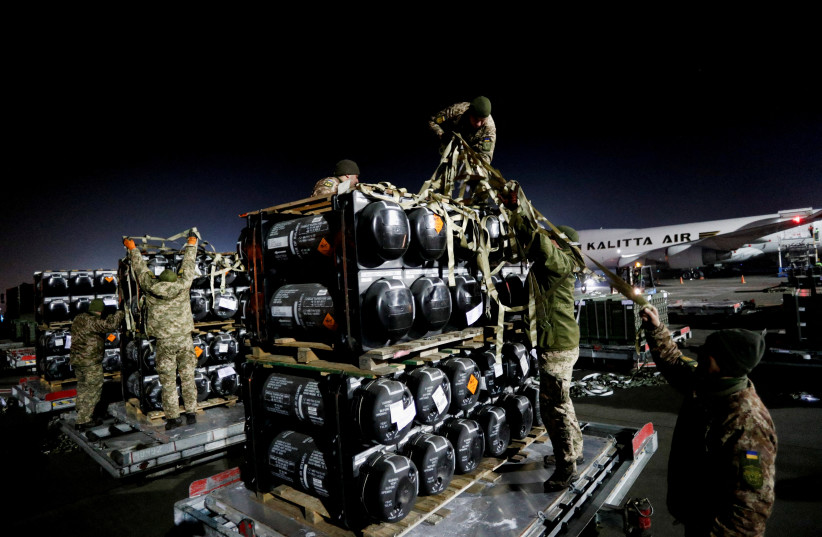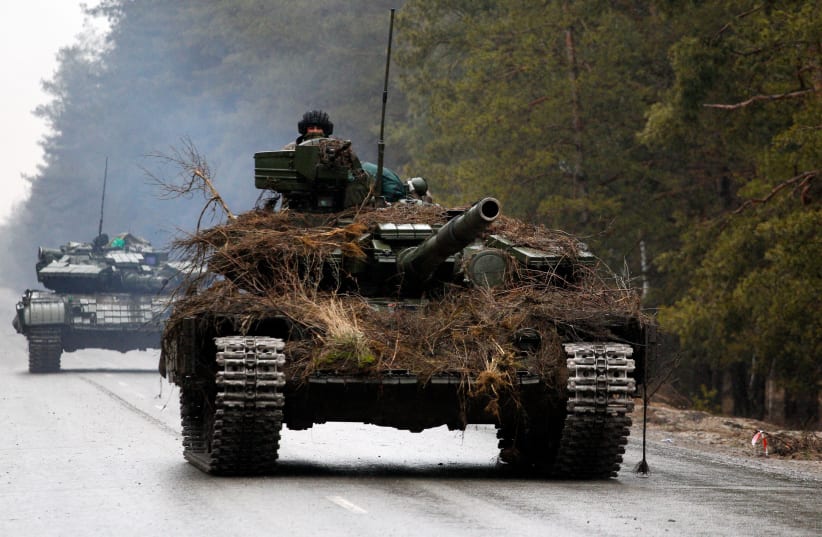In a 21st-century war, tanks are still moving on land and planes are still in the air, but neither are fighting each other.
There have not been any large-scale tank battles or dogfights for years. Those have been relegated to the history books – at least for now.
Armored warfare doctrine was developed to break through the impasse of trench warfare during World War I and provide infantry with more mobile fire support than artillery.
Read more on the Russia-Ukraine War:
- Day 5 of the Russian invasion of Ukraine
- Fuel and logistics problems frustrate Russian advance - analysis
- Roman Abramovich in Belarus assisting in Ukraine-Russia talks at Kyiv's request
- Lukashenko warns of 3rd World War, as Belarus prepares to send troops
- Russian invasion a 'solution to Ukrainian question' - Russian state news
But more than a century after they made their debut during World War I’s Battle of the Somme, and despite remaining a large aspect of most militaries, tanks are fighting each other with decreasing frequency.
Like tank battles, dogfights – which are still practiced by air forces across the globe, including the IAF – have become just as rare in the post-Cold War era.


Despite upgrading their militaries over the years, the war in Ukraine primarily is being fought using aging Soviet weapons and platforms. The Ukrainians are waiting for new weaponry promised by the West, including anti-tank and -aircraft missiles.
Nevertheless, facing weapons like Javelin anti-tank and Stinger anti-aircraft missiles already provided to Kyiv, Russian armor and aircraft have become sitting ducks for Ukrainians who fire at their targets from standoff ranges.
Russia has one of the most powerful militaries in the world, spending $61.7 billion on its military in 2020.
According to GlobalFirepower.com, which analyzes the military capabilities of countries around the world, Russia is the second-most powerful military in the world.
Ukraine, meanwhile, is ranked No. 22 out of 140.
Russia overpowers Ukraine by far, both in terms of personnel (850,000 vs 250,000) and weaponry.
In terms of airpower, Russia has 4,100 aircraft, including 772 fighter jets, 739 attack aircraft, 445 transport planes, 1,543 helicopters and 544 attack helicopters.
The Ukrainian Air Force is estimated to have about a 13th of that, with 318 aircraft, including about 70 fighter jets, 29 attack aircraft, 32 transport planes, 112 helicopters, 34 attack helicopters and other platforms, such as trainers and drones.
Four days into the most significant European war this century, dozens of these platforms have been downed in the skies over Ukraine, which remains hotly contested.
The European Union Aviation Safety Agency deemed Ukraine’s airspace an “active conflict area” shortly after the outbreak of the war.
According to the agency, the “presence and possible use of a wide range of ground and airborne warfare systems pose a high risk for civil flights operating at all altitudes and flight levels.”
Initial Russian missile barrages targeted airfields where the Ukrainian Air Force operated Soviet-made MiG-29s and Su-27s, and Czech L-39s and where Kyiv based its Russian S-300 missile-defense systems.
ON THE first day of fighting, Russia destroyed four Ukrainian fighter jets, one helicopter and four Turkish-manufactured Bayraktar combat drones.
A video shared on social media showed large craters at various Ukrainian airfields, while other videos showed missiles flying to airports and destroying aircraft, including the world’s largest cargo plane, the Antonov An-225 Mriya.
And while the Ukrainian Air Force has been degraded by an estimated 320 ballistic and cruise missiles fired by Russia, the Russian Air Force has yet to secure air superiority, and Ukrainian air-defense systems continue to take down Russian aircraft.
Even though Ukraine is far overpowered by Russia, Kyiv very likely studied how Syrian Islamists and Kurdish rebels were able to destroy countless Russian and Turkish tanks during their devastating civil war, which Moscow entered in 2015 on the side of Syrian President Bashar Assad.
While Assad has reconsolidated power thanks to the Iranians and Russians, he only holds control of 64% of Syrian territory. Russia helped, but Assad couldn’t get everything back under his power due to the tenacity of Islamist rebels in Idlib and the Kurdish-led Syrian Democratic Forces in Rojava.
The Ukrainians undoubtedly studied how guerrilla warfare was perfected in Syria, where Moscow tested out countless new weapons systems, as well as employed older equipment, and learned from the heavy losses Russia and its local allies suffered.
What is curious is how little of the Russian gear being used in Syria has been employed in Ukraine, where, for example, most of the armored personnel carriers and tanks are of 1980s vintage, if not older, and clearly vulnerable to modern Western anti-tank guided missiles and anti-tank rockets.
The underdog Ukrainian military is putting up a valiant fight on land, at sea and in the air. Russian tank columns are being destroyed by Ukrainian missiles, while Russian aircraft, including large IL-76 transports ferrying troops, continue to fall from the sky.
The war between Kyiv and Moscow is being played out on YouTube, Twitter, Facebook and Snapchat in real time. While that provides mountains of videos of destroyed hardware and platforms, and unconfirmed reports of Ukraine’s “Ghost of Kyiv” fighter ace downing six Russian aircraft on the first day of the invasion, we have yet to see footage of dogfights and tank battles.
It just might be that 21st-century warfare will not be fought army against army, but by soldiers who fire their modern missiles at their enemy – and forget – as they select their next targets.
